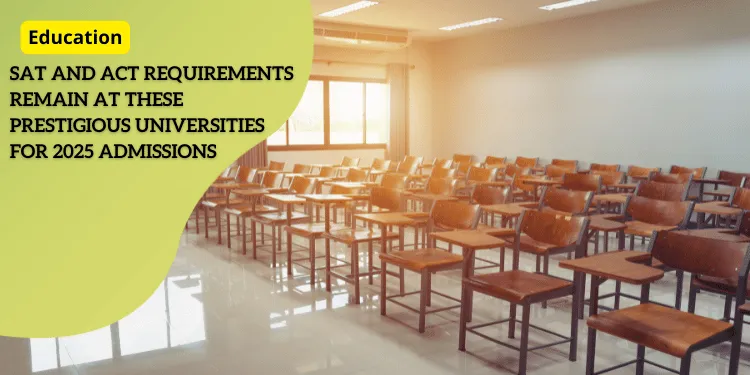SAT and ACT Requirements Remain at These Prestigious Universities for 2025 Admissions

Anúncios
Current Landscape of College Testing Requirements
Navigating the current college admissions landscape can be quite a journey, especially with the evolving dynamics around standardized testing requirements.
As we look toward fall 2025 admissions, over 80% of schools have adopted test-optional or test-blind policies.
Anúncios
This shift signifies a monumental change in evaluating prospective students, focusing less on SAT and ACT scores and more on holistic assessments.
Dominance of Test-Optional and Test-Blind Policies
The wave of change can be attributed to several factors, including the pandemic-induced disruptions and a growing recognition of the limitations of standardized tests.
Anúncios
Colleges aim for a more inclusive application process by reducing the weight of standardized tests.
This move has leveled the playing field, allowing students from diverse backgrounds to shine through other aspects of their applications.
Prestigious Institutions Standing Firm
Despite the broad adoption of test-optional and test-blind policies, some prestigious universities maintain mandatory testing requirements.
These institutions argue that standardized tests offer a uniform metric to compare applicants from varied educational backgrounds.
However, their stance sets them apart in an increasingly flexible landscape.
As you consider your college choices, it’s crucial to stay updated on individual admissions policies.
Understanding which schools require standardized test scores can help align your preparation strategies effectively.
Next, we’ll explore which leading public universities still cling to these test requirements, along with their rationale.
Leading Public Universities with Test Requirements
While many universities are shifting towards test-optional or test-blind admissions policies, certain leading public institutions still uphold test requirements, ensuring a critical and standardized evaluation of applicants.
High-Ranking Public Universities
Among the top 17 colleges maintaining test mandates, eight are public institutions.
Remarkably, the University of California–Los Angeles (UCLA) leads this group.
Tied at No. 30 in the overall rankings, UCLA stands out as the highest-ranked public National University demanding SAT/ACT scores.
This commitment underscores UCLA’s dedication to maintaining rigorous academic standards.
Service Academies’ Standards
Two prestigious service academies, the U.S. Air Force Academy in Colorado and the U.S. Military Academy (West Point) in New York, also enforce test requirements.
Both academies exemplify the highest standards among public National Liberal Arts Colleges.
The Air Force Academy boasts a “middle 50%” SAT range of 1250-1450, while West Point leads with an ACT range of 28-33.
Strict test requirements at these academies ensure cadets are academically prepared for their challenging programs and future leadership roles.
Lowest and Highest Score Ranges
Public universities display a remarkable range in test score requirements.
The lowest “middle 50%” ranges include Florida State University (ACT 27-31) and Purdue University (SAT 1190-1470).
On the other end, the highest ranges are dominated by these top-tier institutions.
For instance, the “middle 50%” score at one of the highest-ranking schools stretches from 1510-1580 for the SAT and 34-36 for the ACT, demonstrating the competitive nature of admissions.
The focus now turns to the specific score ranges among National Universities, reflecting the stringent standards maintained by institutions that still require standardized tests.
Score Ranges at National Universities
Prestige and Performance
When it comes to National Universities still demanding SAT and ACT scores, the performance bar remains exceptional.
Notably, the highest “middle 50%” range for SAT scores sits across top-tier institutions from 1510 to 1580.
In terms of the ACT, that same bracket stretches from 34 to a perfect 36.
These elite scores highlight the fierce competition and high standards maintained by these prestigious schools.
The Highest and the Lowest
While top institutions set the bar high, there’s a considerable range within National Universities.
At the upper echelon, students aspiring to schools like the University of California–Los Angeles and other high-ranking universities need to aim for near-perfect scores.
On the other end, Florida State University and Purdue University have more accessible ranges among the required-testing group.
At FSU, the “middle 50%” ACT scores fall between 27 and 31, while Purdue’s SAT score range is 1190 to 1470.
Although these scores are relatively lower by comparison, they still reflect the schools’ rigorous standards.
Aiming for Perfection
For students setting their sights on these competitive programs, knowing the maximum possible scores can help set realistic goals.
The SAT caps at 1600, while the ACT peaks at 36. Understanding these benchmarks is key to effective test preparation and strategic planning for admissions.
As we navigate through the evolving landscape of college testing requirements, it’s clear that while many institutions are easing up on test mandates, others uphold stringent standards.
Ensuring awareness of these varying score requirements is essential for students tailoring their college applications to match their academic profiles.
Stay tuned as we explore the testing standards for Liberal Arts Colleges, highlighting the range of expectations and how they compare to National Universities.
Liberal Arts Colleges Testing Standards
When considering liberal arts colleges requiring SAT and ACT scores for 2025 admissions, the standards are notably rigorous.
Unlike many institutions that have shifted to test-optional or test-blind policies, these colleges continue to place emphasis on standardized testing as a crucial part of their selection process.
SAT Ranges at Leading Liberal Arts Colleges
The U.S. Air Force Academy stands out with the highest “middle 50%” SAT score range, spanning from 1250 to 1450.
This means that the majority of students admitted here scored within this range on the SAT.
This prestigious institution maintains high standards to ensure its students demonstrate strong academic capabilities.
ACT Ranges at Leading Liberal Arts Colleges
West Point, also known as the U.S. Military Academy, takes the lead in ACT requirements with a “middle 50%” range of 28-33.
This high bar signifies the academy’s commitment to admitting students who excel in various sections of the ACT, reflecting their preparedness for rigorous academic and military training.
Lowest Score Ranges at Liberal Arts Colleges
On the other end of the spectrum, Centre College in Kentucky presents the lowest “middle 50%” score ranges among the top liberal arts colleges still requiring standardized tests.
Here, the SAT score range is from 990 to 1180, and the ACT range is between 18 and 24.
While Centre College still values standardized testing, its thresholds are relatively more accessible, providing opportunities for a broader range of applicants.
These varying score ranges highlight the diverse approaches among liberal arts colleges still upholding test requirements.
Whether you aim for the high benchmarks set by the U.S. Air Force Academy and West Point or target the more attainable criteria of Centre College, understanding these standards can help you better prepare for your application journey.
Geographic Distribution
As the landscape of college admissions evolves, geography plays a significant role in the testing requirements upheld by various institutions.
Florida emerges as a leader in maintaining standardized test mandates, with three schools still requiring SAT or ACT scores.
This includes high-profile universities that continue to use these metrics to evaluate their applicants.
Florida Leads the Pack
Florida is home to three significant institutions that have retained their test requirements.
These universities set a robust example by adhering to traditional admission metrics while many others have adopted test-optional policies.
Prospective students looking to apply to schools in Florida will still need to prepare for these standardized exams to meet the application criteria.
Georgia and Massachusetts Follow Suit
Not far behind, Georgia and Massachusetts each have two schools that require standardized test scores.
This adds a layer of complexity for applicants considering these states, as they must navigate through the requirements set by individual colleges.
In both states, this adherence to testing standards offers a mix of opportunities for those who excel in standardized testing.
Diverse Representation Across the U.S.
Beyond these leading states, testing requirements are seen across a broad geographic spectrum, covering states like California, Colorado, Idaho, Indiana, Kentucky, New Hampshire, New York, Rhode Island, Virginia, and Washington, D.C.
This diverse representation indicates that testing norms vary widely depending on the region and the institution’s priorities.
For instance, states like California and New York, known for their prestigious universities, maintain a blend of both test-required and test-optional schools.
This broad geographic distribution signifies that while the majority of schools are moving towards test-optional policies, a substantial number still hold onto traditional measures, providing varied choices for applicants nationwide.
This pattern of distribution underscores the importance of researching each school’s admissions policies comprehensively.
By understanding these geographic trends, applicants can tailor their preparation efforts, ensuring they meet the specific requirements of their target institutions without any surprise hurdles.






